
Holy Monastery of Great Lavra
The Holy Monastery of Great Lavra, or Megisti Lavra, (founded around 963) is on the south-eastern side of the Athos peninsula at a place called Melana, an area where fragments of monuments which take us back to the pre-Christian era are to be found.
The Lavra occupies first place in the history and hierarchy of the monasteries of Athos, and its founder was the most honored figure among the monks of the Holy Mountain - Saint Athanasius the Athonite. It was Saint Athanasius who introduced into what up till then had been a monasticism of cave-dwelling hermits the coenobitic system, which was afterwards to become the monastic way of life. Tradition holds that arriving from Trapezounta (Trabzon) Saint Athanasios wanted to build the monastery a little to the north from its current location. But Virgin Mary showed herself to the monk and indicated the present place where the monastery is built. To be sure that he understood the message correct the Saint hit one rock in the forest nearby and water started to run from it. The spring is located near the monastery and is called today The Holy spring of Saint Athanasios.
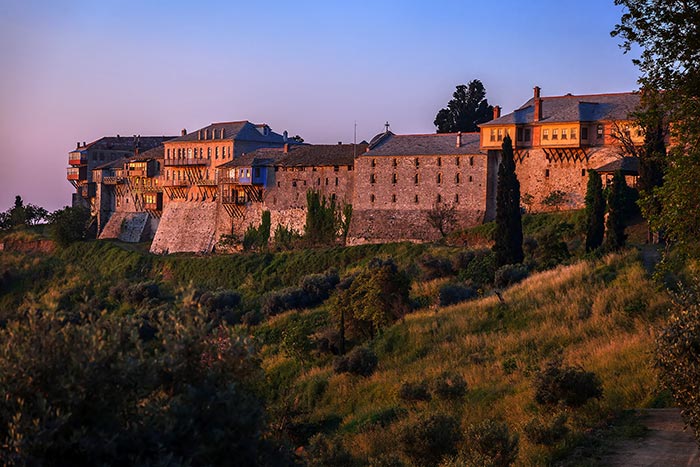
With the permission of the Emperor Romanus II, Athanasius began building works. Soon afterwards, his friend Nicephorus Phocas became Emperor and supported him in a variety of ways. The Katholikon was built first; very soon large numbers of many nations and languages, some distinguished and others totally undistinguished, flocked to lead the monastic life under the direction of the Saint. The policy of support of Phocas was continued by his successors Tsimiskes and Basil II (nicknamed) the Bulgar-slayer, in spite of opposition to St Athanasius in some quarters.
After the death of St Athanasius, the rule over the Lavra was taken over, at the command of the Saint, by the founder of the Iviron Monastery, Saint John, and the patrician Nicephorus Uranus. The Monastery had long been flourishing and gradually acquired many donations. Apart from the solemnion (an annual grant of gold pieces) established by Phocas and Tsimiskes, Basil II gave the Monastery an island (near Skiathos). By degrees, the Monasteries of Gomatos, Monoxylitos, and of the Amalfitans came into its possession, together with Kalykas, Xerokastron, and the Platys Gulf. These acquisitions were confirmed by imperial chrysobulls of Andronicus II and the Despot Demetrius Palaeologus (1429).
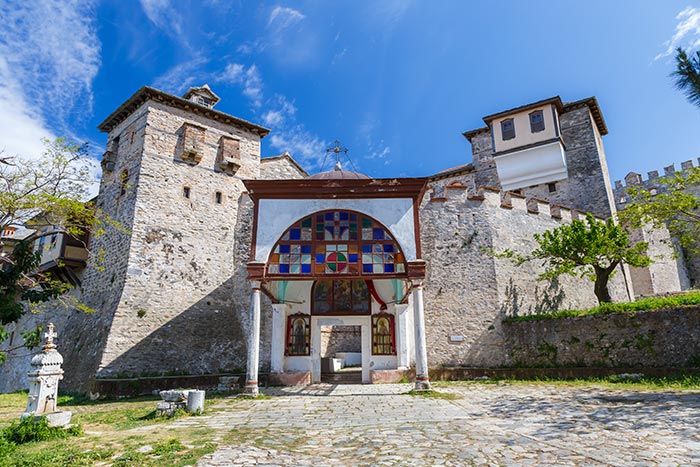
The Prince of the Serbs Stefan Dusan, like other later Slav princes, showed himself generous towards the Lavra. The Monastery remained a coenobium until the 14th century, but pirate raids led to a breakdown of its organization and it was dealt severe blows by a number of earthquakes, such as that of 1585. The burden of taxation on the monasteries during the years of Turkish rule, borne almost entirely by the Lavra and the Vatopedi and Iviron Monasteries, also contributed to its gradual decline.
The conversion of the Lavra into an idiorhythmic monastery in the 14th century led to it to follow a Typikon (observance) all of its own, similar to those of the monasteries of Palestine. In 1574, the Patriarch of Alexandria Silvestros intervened and the Monastery returned to the coenobitic way of life, only to become idiorrhythmic again in 1670.
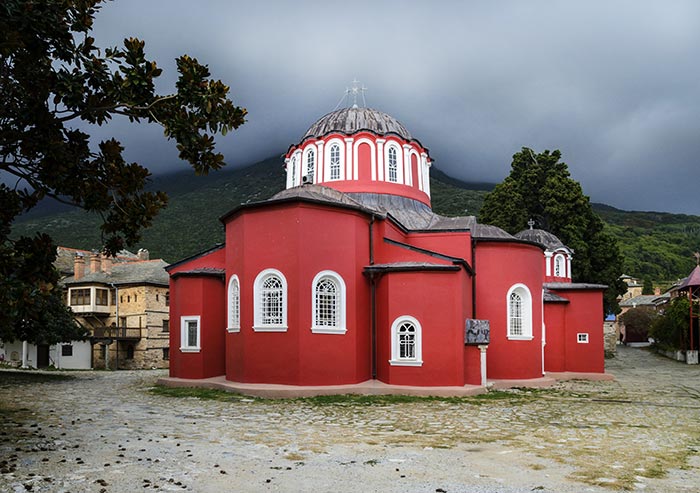
Although the monastery was originally dedicated to the Annunciation of the Blessed Virgin, on the death of St Athanasius, he became monastery’s patron saint. The original buildings dated from 963, but the history of its construction passes through a number of subsequent phases, as is the case with most Athonite Katholikon. The core of the Katholikon was built by the saint around the year 1000. The 5th of July is celebrated in memory of St Athanasios, whose tomb is in the chapel of the Forty Martyrs. The wall-paintings of the Katholikon are by Theophanes of Crete (1535), those in the chapel of St. Nicholas by Frangos Catelanos (1560) and those of the refectory are probably the work of one of his pupils.
The narthex of Katholikon was painted much later in 1854. South of narthex, there is the chapel of Saint Nicholas, painted by Franco Cantellano, in 1560.Outside the Katholikon is the Fiali (font) for holy water, the largest on Mount Athos. The Monastery has 17 chapels and 19 outlying chapels.
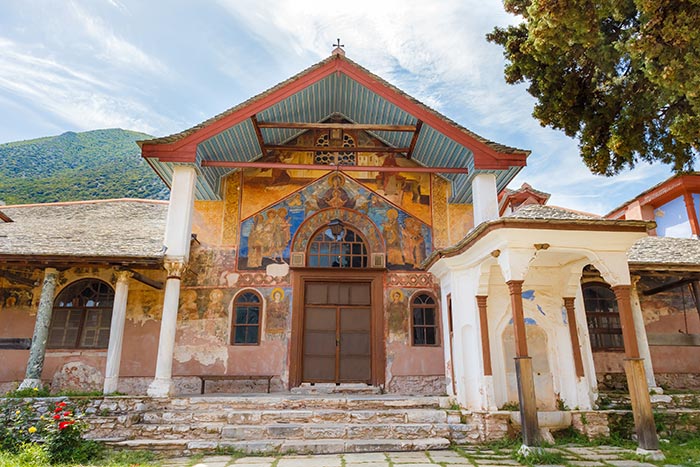
Among the many priceless treasures of the Monastery is the icon of Our Lady Koukouzelissa, patriarchal and imperial dalmatics, and sacred relics. According to tradition the main psalm singer of the monastery Ioannis Koukouzelis had such a talent that Mother of God herself would come to listen to him. She would ask to perform especially for her paying to Koukouzelis with one golden coin.
The library of the Lavra has some 2,116 manuscripts, 20,000 printed books, and about 100 manuscripts in foreign languages. The three famous Skites of St John the Baptist, St Anne (Aghia Anna), Prodromou and Kafsokalyvia, the groups of kalives of Mikri Aghia Anna, Katounakia, Karoulia, Kerasia, and others, the famous Kelia of Mylopotamos, St Nilus, and the ascetics' retreats of St Peter the Athonite, St Athanasius, and St Nilus are all possessions of the Lavra, as well as the so-called “Desert” or wilderness at the tip of the Mount Athos peninsula.
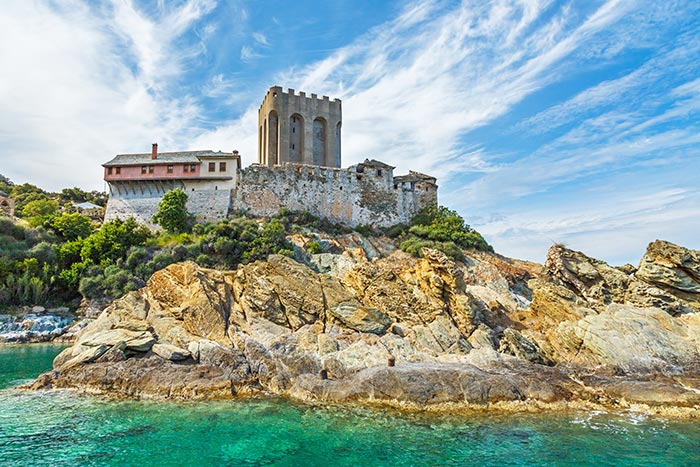
The historic Kelia of Provata and Karyes also belong to it. In 1963, the Megisti Lavra, together with the whole of the Holy Mountain, celebrated its thousandth anniversary. In 1980, the Monastery returned to the coenobitic system.


